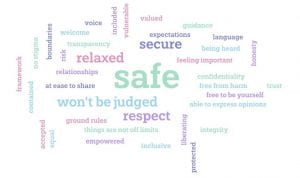The CAMH team have gained some funding to extend our previous project, which we conducted along with our MSc CAMH student, Jessica Renew. This project will be exploring Lecturers and Postgraduate Students experiences of felt safety within the classroom. In addition to the CAMH team, Kathryn Congreve will be a Researcher conducting and delivering the project work- thanks for joining the team, Kat 🙂
Is safety the right word?
One of the questions that motivated this area of research in the very beginning was this idea of ‘safe’ classrooms. When we think of being ‘safe’, we think of a sense of comfort and a felt sense of security. However, a key part of our course-and much postgraduate learning- is the need to explore outside these ‘safe’ and ‘bounded’ spaces.
Sitting within a space of comfort, entails that we do not unpack what makes us feel uncomfortable-and why. Why do topics around disabilities, race, inequities, poverty etc., make some of us feel uncomfortable?
Part of working with children, young people and families is that we will need to work with diverse experiences and realities, some of which may not feel familiar or ‘ok’ to us. If we were not to use the classroom as a space through which we could explore difficult, prejudicial, discriminatory and oppressive topic areas, we would not creating a sense of ‘readiness’ for our future work as practioners (Thompson, 2017). Thus, ‘safe’ spaces was born.

Our initial discussions with our students and staff at the University of Northampton raised that there may be other ways to catergorise this felt sense of safety, instead focusing on how these spaces make you feel (e.g. a sense of being ‘heard’, ‘valued’, ‘important’, ‘at ease’, ‘accepted’, ‘equal’, ‘welcome’ and ‘free’) (See, Renew, McAllister, Ward and Young, 2021 in link above).
Find a clearer version of this image here.
How will the project work?
This year long project will be using participatory methods to explore postgraduate students’ experiences of feeling valued, heard and/or at ease within the classroom, with a particular focus on the teaching and learning of uncomfortable topics. During these discussions we will also collaboratively create experience-led scenarios to scaffold the discussions around safe teaching spaces with educators. There will be an emphasis on strategies that educators and students feel do/have worked when delivering challenging topics. The experiences of staff and students will then be used to co-produce recommendations and a workbook for the purpose of supporting future teaching and learning spaces at the University of Northampton.
What will the project do?
Early discussions with students and educators indicated a deep need to better consider our learning and teaching spaces. It is important to extend these findings to other subjects areas such as nursing, counselling and early years. Extending the findings will provide us with a more solid foundation to offer useful and practical advice for fellow practitioners within Higher Education (Bowen & Shope, 2014; Flesney & Von Der Lippe, 2019; Thompson, 2019). Further, more support for staff and students will ensure that difficult conversations are not avoided (Hunt, 2016; Bowen & Shope, 2014) and that certain voices and experiences are not rendered invisible (Souto-Manning and Lanza, 2018).
Sounds exciting, right? Don’t forget to subscribe on our blog to find out more about the progress of our project. Want a more visual overview? We will be uploading a video on our Youtube channel very soon!
